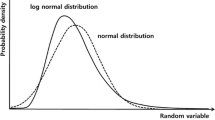Abstract
Coal mine reclamation projects are very expensive and require coordination of local and federal agencies to identify resources for the most economic way of reclaiming mined land. Location of resources for mine reclamation is a spatial problem. This article presents a methodology that allows the combination of spatial data on resources for the coal mine reclamation and uses GIS analysis to develop a priority list of potential mine reclamation sites within contiguous United States using the method of extrapolation. The extrapolation method in this study was based on the Bark Camp reclamation project. The mine reclamation project at Bark Camp, Pennsylvania, USA, provided an example of the beneficial use of fly ash and dredged material to reclaim 402,600 sq mi of a mine abandoned in the 1980s. Railroads provided transportation of dredged material and fly ash to the site. Therefore, four spatial elements contributed to the reclamation project at Bark Camp: dredged material, abandoned mines, fly ash sources, and railroads. Using spatial distribution of these data in the contiguous United States, it was possible to utilize GIS analysis to prioritize areas where reclamation projects similar to Bark Camp are feasible. GIS analysis identified unique occurrences of all four spatial elements used in the Bark Camp case for each 1 km of the United States territory within 20, 40, 60, 80, and 100 km radii from abandoned mines. The results showed the number of abandoned mines for each state and identified their locations. The federal or state governments can use these results in mine reclamation planning.






Similar content being viewed by others
References
P. A. Burrough R. A. McDonnell (1998) Principles of geographical information systems. Oxford University Press New York
InstitutionalAuthorNameESRI (Environmental Systems Research Institute Inc.) (1992a) Arc/Info user’s guide: Arc command references: commands A-I. ESRI Redlands, California
InstitutionalAuthorNameESRI (Environmental Systems Research Institute Inc.) (1992b) Arc/Info user’s guide: grid command references: operators, statements, and commands functions A–F. ESRI Redlands, California
Kidner, D., M. Dorey, and D. Smith. 1999. What’s the point? Interpolation and extrapolation with a regular grid DEM. Proceedings of the 4th international conference on geocomputation. GeoComputation 99. Mary Washington College, Fredericksburg, Virginia, USA, 25–28 July 1999
P. A. Longley M. F. Goodchild D. J. Maguire D. W. Rhind (2001) Geographic information systems and science. John Wiley & Sons New York
McCarl, B.A., Richardson, M. Schilling, R. Srinivasan, J. Stuth, and J. Vitale. 1999. Impact methods to predict and assess contributions of technology (IMPACT). Final report, Assessment Group, Texas Agricultural Experiment Station, Texas A&M University System. In collaboration with Kenyan Minister of Agriculture, Kenya Agricultural Research Institute, International Livestock Research Institute, Institute of Rural Economy, and Institute of Sahel
V. Q. Minh V. P. Singh (2002) ArticleTitleMethodology for agricultural technology extrapolation using GIS. Vietnam Agricultural Journal 1 2002 Occurrence Handle1:CAS:528:DC%2BD3MXnvVentr4%3D Occurrence Handle11504725
NAAMLP (National Association of Abandoned Mine Lands Programs). 2003. http://www.osmre.gov/aml/inven/zintroin.htm (last accessed May 2003)
Natural Resources Conservation Service. 1981. Conservation practice standard. Land reclamation, abandoned mined area, highwall treatment, Code 456
PADEP (Pennsylvania Department Environmental Protection). 2002. Bark Camp Home Page. http://www.dep.state.pa.us/dep/DEPUTATE/MINRES/BAMR/bark_camp/barkhome page.htm (last accessed February 2003)
Pontius R. G., Jr., L. Claessens, C. Hopkinson, Jr., A. Marzouk, E. B. Rastetter, L. C. Schneider, and J. Vallino. 2000. Scenarios of land-use change and nitrogen release in the Ipswich watershed, Massachusetts, USA. 4th International Conference on Integrating GIS and Environmental Modeling (GIS/EM4): Problems, Prospects and Research Needs. Banff, Alberta, Canada, 2–8 September 2000
Rogala, J. T., and D. M. Soballe. 1998. A GIS model for predicting winter habitat suitability in backwaters of the upper Mississippi River. Project status report PSR98-01. Upper Mississipi River, long term resource monitoring program. United States Geological Survey
C. D. Tomlin (1990) Geographic information systems and cartographic modelling. Prentice Hall Englewood Cliffs, New Jersey
US Army Corp of Engineers. 2001. http://www.wrsc.usace.army.mil/ndc/drgmatdisp.htm (last accessed June 2002)
US Department of Energy. 2003. http://www.eia.doe.gov/cneaf/electricity/page/eia861a.html and http://www.eia.doe.gov/cneaf/electricity/page/eia861.html (last accessed January 2003)
US Geological Survey. 2003. GIS data: http://nationalatlas.gov/atlasftp.html (last accessed January 2003)
Voros, A. S., P. Linman, E. F. Giovanitti and S. C. Sands. 2002. Mine reclamation using dredged materials and coal ash. 24th National Association Abandoned Mines Land Projects conference proceedings, Reclamation 2002: partnership & project implementation, 15–18 September 2002, Park City, Utah
K. Zimmermann F. Kienast (1995) ArticleTitleDas Klima lässt sich nicht kartieren - Klimakarten werden gerechnet. Informationsblatt des Forschungsbereiches Landschaft 27 1–3
Acknowledgements
The NY/NJ Clean Ocean and Shore Trust (COAST) provided software and suggested this analysis. New York City Department of Environmental Protection provided necessary high-computing equipment and computer time.
Author information
Authors and Affiliations
Rights and permissions
About this article
Cite this article
Gorokhovich , Y., Voros, A., Reid, M. et al. Prioritizing Abandoned Coal Mine Reclamation Projects Within the Contiguous United States Using Geographic Information System Extrapolation. Environmental Management 32, 527–534 (2003). https://doi.org/10.1007/s00267-003-3043-1
Published:
Issue Date:
DOI: https://doi.org/10.1007/s00267-003-3043-1




